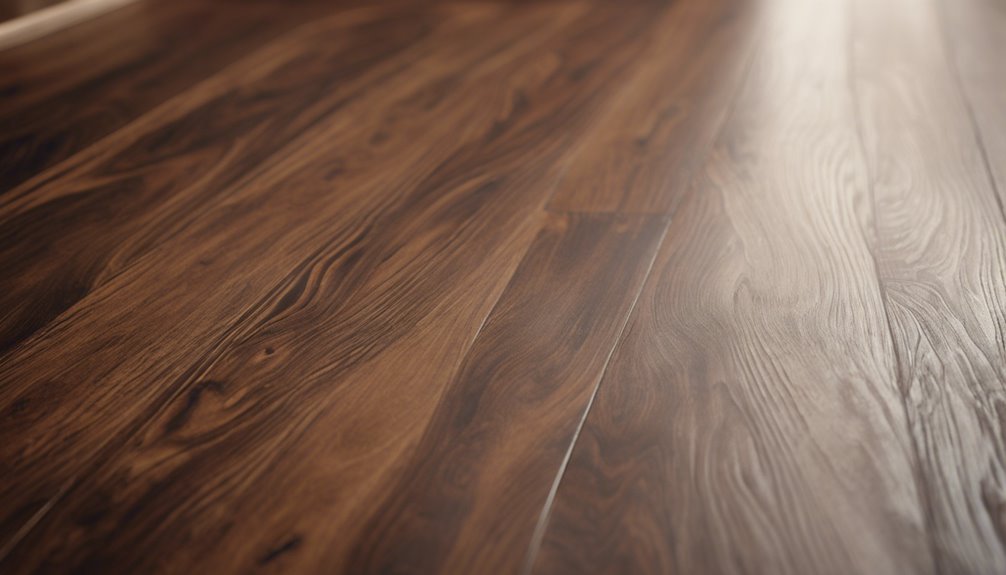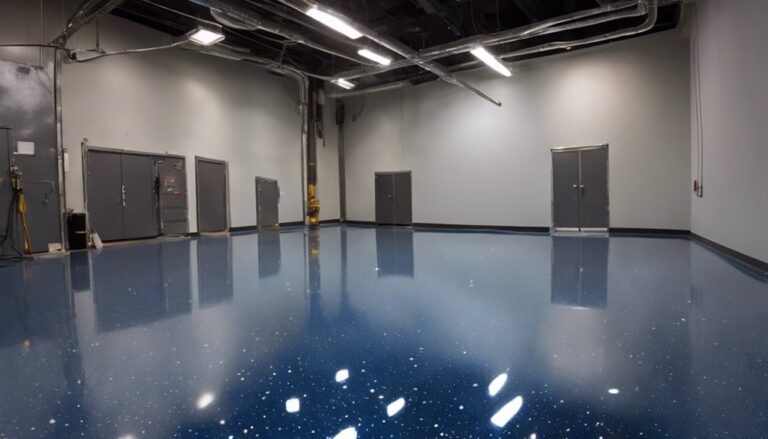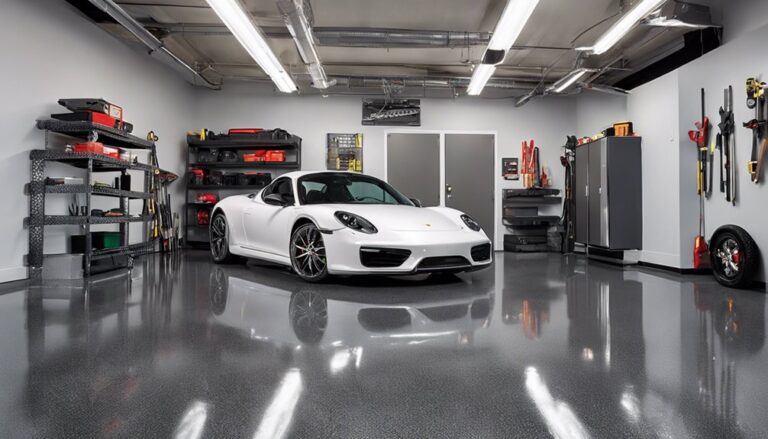Laminate flooring costs between $1 and $5 per square foot. The final price can vary based on quality, design, and room size. If you plan to hire a professional, installation fees can also range from $1 to $5 per square foot. Additionally, consider expenses for underlayment and adhesives, which can affect your total budget. Maintenance costs over time should also be part of your planning, as laminate can last 15 to 25 years with proper care. Understanding these elements helps you create a realistic budget. Want to know more about the best options for your space?
Average Cost Per Square Foot
When you're considering laminate flooring, it's essential to understand the average cost per square foot, as this can greatly influence your budget. Typically, prices range from $1 to $5 per square foot, depending on quality and design. For budget planning, aim for a balance between affordability and durability; a mid-range option often provides the best value. Conducting a cost comparison among various suppliers allows you to spot the best deals, ensuring you get the most bang for your buck. Remember, installation costs may also vary, so factor that into your overall budget. By knowing the average costs upfront, you empower yourself to make informed decisions that align with your financial goals and personal style.
Factors Affecting Costs
When you're considering laminate flooring, several factors can impact the overall cost. The quality of the materials you choose, the method of installation, and the size of the room all play significant roles in determining your final price. Understanding these aspects will help you make informed decisions and stay within your budget.
Material Quality Impact
The quality of laminate flooring materials plays a significant role in determining overall costs. When you consider different material grades, you'll find that higher-grade options often come with a higher price tag due to enhanced durability and better aesthetic appeal. For instance, thicker planks and those with a high-density fiberboard core typically resist wear and tear better.
In a durability comparison, lower-grade laminates may be more susceptible to scratches and fading, leading to potential replacements sooner rather than later. Investing in higher-quality materials not only elevates your space but can save you money in the long run. Ultimately, choosing the right laminate flooring involves balancing your budget with your desire for lasting quality and style.
Installation Method Choice
Choosing the right installation method for your laminate flooring can greatly affect overall costs. You've got two main options: hiring professionals or going the DIY route. Professional installation techniques can save time and guarantee a flawless finish but will add to your budget. On the other hand, if you're handy and comfortable with tools, a DIY approach can considerably cut costs. Just remember to factor in any tools or materials you might need. Additionally, consider the complexity of the installation; simpler layouts will be easier and cheaper to tackle yourself. Ultimately, the choice between professional vs. DIY hinges on your skills, budget, and how much freedom you want in the process.
Room Size Considerations
Your decision on installation methods can lead you to contemplate how room size impacts the overall cost of laminate flooring. Larger room dimensions often mean you'll need more materials, which can increase your budget. Additionally, layout considerations play a vital role. Open spaces might require fewer cuts, while complex layouts could lead to more waste and higher labor costs.
| Room Size | Estimated Cost |
|---|---|
| Small (100 sq ft) | $800 – $1,200 |
| Medium (200 sq ft) | $1,600 – $2,400 |
| Large (400 sq ft) | $3,200 – $4,800 |
| Extra Large (600 sq ft) | $4,800 – $7,200 |
Keep these factors in mind when planning your flooring project to guarantee you're making a cost-effective choice.
Installation Fees Explained
Although many homeowners focus on the price of laminate flooring itself, installation fees can greatly impact the overall cost. Understanding the installation process is essential for budgeting. Typically, professionals charge per square foot, and you'll want a detailed cost breakdown that includes labor, any necessary tools, and preparation tasks like removing old flooring. Expect to pay anywhere from $1 to $5 per square foot depending on your location and the complexity of the job. If you're handy and prefer to take the DIY route, you might save on labor costs, although you'll still need to factor in your time and any tools you may need to rent or buy. Ultimately, knowing these fees helps you make informed decisions.
Additional Material Expenses
While laminate flooring is often praised for its affordability, there are additional material expenses that can greatly influence the total cost. One vital element is the underlayment options you choose. This layer not only provides cushioning but also moisture protection and sound reduction. Depending on your needs, you might opt for foam, cork, or even rubber underlayment, which can vary greatly in price.
Additionally, if you're not using a click-lock system, you'll need to take into account adhesive types. Different adhesives serve various purposes, such as moisture resistance or quick-drying capabilities, and their costs can add up. By being mindful of these additional material expenses, you can guarantee your budget stays on track while achieving the look and feel you desire in your space.
Long-Term Cost Considerations
When considering laminate flooring, think about the long-term costs that come with maintenance and repairs. While laminate is often budget-friendly upfront, its lifespan and durability can greatly impact your overall investment. You'll want to assess how often you might need to replace or repair it to get a true picture of its long-term value.
Maintenance and Repair Costs
As you consider laminate flooring, it's essential to factor on long-term maintenance and repair costs, which can greatly impact your overall budget. Regular cleaning techniques like sweeping and damp mopping will help maintain your floor's appearance, but you may need to invest in specific cleaning products designed for laminate to avoid damage. Regarding repair options, minor scratches and dents can often be addressed with a laminate repair kit, which is usually affordable. However, if significant damage occurs, replacing individual planks might be necessary. Understanding these costs upfront can help you allocate your resources wisely, ensuring that your beautiful laminate flooring remains a cost-effective choice for years to come.
Lifespan and Durability Factors
Understanding the lifespan and durability of laminate flooring is key to evaluating its long-term value. Typically, the laminate lifespan ranges from 15 to 25 years, depending on quality and maintenance. Higher-grade laminates often endure wear and tear better, making them a smarter investment. Durability testing reveals how well the flooring withstands scratches, moisture, and heavy foot traffic.
To maximize longevity, consider factors like installation methods and environmental conditions. Proper care, like regular cleaning and avoiding excess moisture, can extend its life considerably. When choosing laminate, balance upfront costs with potential long-term savings, as a more durable option might save you from future replacements. Ultimately, understanding these factors empowers you to make an informed decision that suits your lifestyle.
Comparing Laminate to Other Flooring
While laminate flooring offers a cost-effective and versatile option for homeowners, comparing it to other flooring materials reveals both its strengths and weaknesses. One of the main laminate advantages is its affordability compared to hardwood. You can achieve a similar aesthetic without breaking the bank. However, hardwood's natural beauty and longevity often outshine laminate regarding resale value. In hardwood comparisons, consider maintenance; laminate is easier to clean and resistant to scratches, making it ideal for busy households. Yet, it may lack the warmth and authenticity that some seek. Ultimately, your choice will depend on your budget, lifestyle, and aesthetic preferences, weighing the laminate advantages against the timeless charm of hardwood.
Frequently Asked Questions
How Long Does Laminate Flooring Typically Last?
Laminate flooring typically has a lifetime expectancy of 15 to 25 years, depending on the quality you choose and how you maintain it. Did you know that higher-grade laminate can outperform some hardwoods in durability? This means you can enjoy your space without worrying about wear and tear for years. Proper care, like regular cleaning and avoiding excessive moisture, can greatly enhance its flooring durability, giving you the freedom to enjoy your home worry-free.
Can I Install Laminate Flooring Over Existing Floors?
Yes, you can install laminate flooring over existing floors, but you'll need to verify flooring compatibility first. It's important to check for any uneven surfaces and moisture issues. For installation tips, make certain to use an underlayment for added cushioning and soundproofing. Additionally, avoid installing over carpet, as it can cause instability. By following these guidelines, you can achieve a smooth and durable finish that complements your space perfectly.
Is Laminate Flooring Suitable for High-Moisture Areas?
While laminate flooring offers a stylish look, it isn't the best choice for high-moisture areas like bathrooms or basements. Its moisture resistance is limited, and excess water can lead to warping. If you're keen on using it, consider moisture-resistant options and guarantee proper installation tips, like using a vapor barrier. This way, you can enjoy the beauty of laminate while protecting your space from potential damage. Balance style and practicality for your freedom in design!
What Are the Best Brands for Laminate Flooring?
When you're looking for the best brands for laminate flooring, it's crucial to explore brand comparisons and flooring reviews. Brands like Pergo, Shaw, and Mohawk often top the lists, known for their durability and style. You'll want to evaluate factors like warranty, thickness, and design options. Reading customer reviews can give you insights into real-world performance, helping you make a choice that fits your lifestyle and aesthetic preferences perfectly.
How Do I Clean and Maintain Laminate Flooring?
Imagine your laminate floor as a garden; it flourishes with care. For cleaning, use a soft broom or vacuum regularly, avoiding water. A damp mop with a gentle cleaner will revive its shine. Establish a maintenance schedule: deep clean every few months and check for scratches or dents. Remember, like tending to a garden, consistent attention keeps your floor looking vibrant and free, allowing your space to breathe and thrive.




